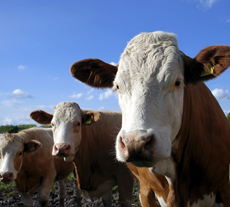Privacy vs. Protection:
Study considers how to manage epidemics in information blackouts
1 November 2012

KNOXVILLE – When foot-and-mouth disease swept through the British countryside in early 2001, more than 10 million sheep, cattle and pigs were slaughtered to control the disease. Despite the devastation, the disease was contained within ten months in part owing to the availability in that country of finely detailed farm data, which enabled mathematical modelers to make accurate predictions about the spread of the disease and suggest optimal ways of managing it.
Should foot-and-mouth disease occur in the United States today where privacy laws restrict the accessibility of data, making predictions about the disease might not be so easy, according to a new study that weighs the costs of privacy in preventing disease outbreaks.
Foot-and-mouth is one disease that livestock owners dread most. It spreads widely and rapidly, infecting cloven-hoofed animals such as cows, pigs, sheep and goats. Infected livestock have to be quarantined and are usually killed.
The costs of an outbreak of foot-and-mouth in the United States could easily exceed $50 billion, which is why the US Department of Homeland Security has labeled it as a threat to national security. The last outbreak of foot-and-mouth disease in the United States occurred in 1929.
The study, which appears in the journal PLOS Computational Biology, utilized land cover maps to approximate the likely location of farms to improve the accuracy of mathematical models that could be used in making disease control predictions. Land cover maps, which aggregate data on habitats rather than providing information on individual farm locations, are the only kind of maps available in the United States where privacy laws protect precise locations of livestock farms in order to protect the anonymity of farmers. The mathematical models in the study showed that highly resolved land cover maps could act as an accurate predictor for farm locations and provide accurate advice regarding the optimal strategy to control disease spread.
In the 2001 foot-and-mouth outbreak, the UK government approved the culling of not only animals on infected farms but also culling of animals on adjacent farms, as they were considered at increased risk of infection. Thus, the precise location of farms is vital knowledge to making epidemiological predictions. While this study focused on the foot-and-mouth outbreak, the method could also be used for planning purposes in the event of a future outbreak of other infectious diseases in livestock.
"The advantage of the current study is that it provides a framework for assessing the potential epidemic impact that might occur in environments that lack sufficient data," said the study's co-author Mike Tildesley from the University of Warwick. Having accurate epidemiological models can help policymakers explore a range of control measures beyond culling, such as vaccination, movement restrictions, and increased farm security.
The study's other author is Sadie Ryan from the State University of New York College of Environmental Science and Forestry. Ryan and Tildesley developed the model as a part of their research as visitors to the National Institute for Mathematical and Biological Synthesis.
Citation: Tildesley MJ, Ryan S. 2012. Disease Prevention versus Data Privacy: Using Landcover Maps to Inform Spatial Epidemic Models. PLoS Computational Biology. [Online]
#
The National Institute for Mathematical and Biological Synthesis (NIMBioS) brings together researchers from around the world to collaborate across disciplinary boundaries to investigate solutions to basic and applied problems in the life sciences. NIMBioS is supported by the National Science Foundation, the U.S. Department of Homeland Security, and the U.S. Department of Agriculture with additional support from The University of Tennessee, Knoxville.
CONTACT:
Catherine Crawley, NIMBioS – (865) 974-9350 ccrawley@nimbios.org
NIMBioS
1122 Volunteer Blvd., Suite 106
University of Tennessee
Knoxville,
TN 37996-3410
PH: (865) 974-9334
FAX: (865) 974-9461
Contact NIMBioS


